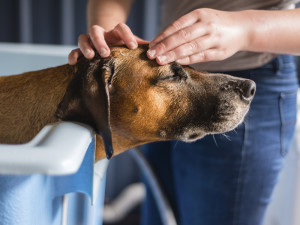How to Tell If Your Dog Has a Tick
Ticks (literally) suck. Keep an eye out for them on your pup.

Share Article
In This Article:
What Does a Tick Look Like on a Dog?opens in a new tab What Should I Do If I Find a Live Tick on My Dog?opens in a new tab What Locations Are Prone To Ticks?opens in a new tab Which Ticks Should I Look Out For?opens in a new tab What Side Effects and Diseases Can Dogs From Ticks?opens in a new tab When Should You Consult a Vet?opens in a new tab
You’d think it would be straightforward to know what a tick looks like on a dog, but it’s easy to confuse a nipple, scab, or skin tag with a tick. Dogs do not appreciate it when you try to pull any of those off. Checking your dog regularly for ticks can get familiarize with what’s normal for your dog’s skin. Frequent tick checks are needed for dogs that explore outdoor areas, especially in endemic or heavily wooded areas.
Making checking for ticks a fun, rewarding activity for your dog to help to keep this process easy and stress-free. Basically, you’re doing a whole-body massage to check the skin for anything out of the norm. Your dog doesn’t have to know that there’s a bigger purpose behind it, and they won’t particularly care as long as the rubs are good and there’s a treat at the end.

littleKin™ is Kinship’s home just for puppy and kitten parents. Bop over to check out expert advice, new pet tools, and special deals—all curated for your newest family member.
opens in a new tabThe head, including the ears, is the most common location to find ticks on a dog, but you should check their whole body thoroughly to make sure none are missed. Have your dog roll on their back so you can check between their toes and in their armpits. As far as your pup knows, they’re just getting great scratches while you look through their fur for any unwanted guests. This process can be more challenging on long-haired or thick-coated dogs though.
What do live ticks look like on dogs?
Ticks come in a variety of shapes and sizes depending on their species and life stage. Larval ticks, also called seed ticks, are tiny (about half a millimeter long before feeding) and difficult to find. Nymph ticks and adult ticks look similar enough that they often need to be examined under a microscope by an expert to tell them apart. Adults are a little larger than nymphs, but this size difference isn’t super obvious, especially when they’re feeding.
Before they attach and feed, ticks are generally flat and reddish-brown to dark brown in color. Larval ticks have six legs, while nymphs and adults have eight. These legs are located toward the front of the body. After a tick attaches, and it begins to feed, its back end will enlarge and become lighter in color, often appearing gray. Its previously flat body gradually becomes round and bean-shaped.
The best way to differentiate a tick from a skin tag, nipple, or other skin feature is to look for legs. In a fully engorged tick, the legs will be tiny in comparison to its overall body size, but they should still be visible as small dark lines near the skin. Depending on the type of tick, you may also see its scutum, a small bit of dark tissue on its top side near its attachment to the skin. The hard scutum helps to protect its body from damage.
What do deceased ticks look like on dogs?
Ticks sometimes die while attached to dogs. This can be due to a dog scratching or rubbing to try to remove the tick and rupturing its body that is now too large to be protected by its scutum. Ticks may also die due to medications aimed at preventing tick-borne diseases. Dead ticks will have a desiccated appearance and feel somewhat flaky when moved. They can still be firmly attached in some cases and still need to be removed to help prevent infection.
What should I do if I find a live tick on my dog?
Ticks should be removed to help prevent the spread of disease to your dog and to help break the tick life cycle so that you don’t end up with ticks in your home environment. Your vet’s office can help if you’re not comfortable or don’t know how to remove ticks at home. Never squeeze, crush, or just pull on a tick with your fingers. Crushing or squeezing can result in the back-flow of blood from the tick into your dog, increasing the risk of disease transmission. The goal is to remove the tick without squeezing or leaving behind its head or mouthparts.
How to use a tick remover on your dog
Tick removersopens in a new tab are a great way to get ticks off your dog. They come in a variety of types, including:
Grasping: These are tweezer-like tools. Use the jaws to grasp the tick where its body narrows near the skin (without pinching your dog’s skin). Pull firmly and steadily perpendicular to your dog’s skin in one motion to remove.
Grasping and rotation: These tick-removers look like a pen, but they have two jaws instead of an ink tip. Depress the button on the back to open the jaws and position them at the base of the tick, similar to the tweezers. Release the button slowly to grasp before rotating two or three times to encourage the tick to loosen its grip. Pull away steadily to remove the tick.
Slit: These simple removers have a narrow, V-shaped notch that fits around the base of a tick. Run this tool along your dog’s skin until the tick’s body is firmly in the notch, being careful not to just separate the head from the body. Once the tick is caught in the notch, pull perpendicular to the skin to remove the tick.
Slit and rotation: These tools are often hook-shaped. They have a similar notch to the slit tool, but the hook-shaped handle of the tool allows you to rotate the tick once it’s caught in the notch. Pull with steady, firm pressure to remove the tick after rotating.
So, which device is best? All of them remove ticks with about equal success, but the tweezers tend to leave the tick’s mouthparts behind most commonly, especially when removing immature ticks. A 2018 studyopens in a new tab showed that the slit and rotation devices had the following benefits over the other devices:
Less time to remove ticks
Easier to use
Less force required to pull ticks off
Less reaction (signs of discomfort) from the dog
Fewer mouthparts left behind
While it’s ideal to remove the whole tick with its mouthparts intact, don’t panic if you’re not sure if you got everything. The mouthparts may cause mild irritation but should be taken care of quickly by your dog’s skin defenses.
Always wear gloves when you’re removing ticks and wipe the area with a gentle cleanser after. Watch the spot for any signs of redness, swelling, pain, or discharge that could indicate a local infection. Dispose of ticks by putting them in a small, closed container partially filled with rubbing alcohol.
What locations are prone to ticks?
Ticks are ubiquitous in the continental United States and Hawaii. Alaska does not have native ticks that affect dogs, but the state has seen some dog ticks brought in on visiting pets. The Centers for Disease Control (CDC) has helpful mapsopens in a new tab showing the distribution of different types of ticks found in the continental U.S.
Pet parents most commonly worry about ticks in wooded areas, but they can be found in shady spots in yardsopens in a new tab as well. Ticks will hide in the soil, leave piles, tall grass, and shrubs and attach as dogs contact these objects.
What ticks should I look out for?
There are many different tick species in the U.S., and many of them will use dogs as a host. These ticks can carry a variety of diseasesopens in a new tab that can affect your dog. Although tick-borne diseases are always a concern, a dog bitten by a tick will not always get a disease from it. Vaccination, tick medications, and your dog’s immune system can work to prevent infection. Some common tick species of concernopens in a new tab include:
American dog ticks: These can carry Rocky Mountain spotted fever (RMSF) and tularemia.
Brown dog ticks: These ticks are one of the primary vectors for the spread of ehrlichiosis. They can also carry babesiosis, anaplasmosis, RMSF, and hepatozoonosis.
Gulf Coast ticks: These ticks are found primarily in the Southeastern U.S. and can transmit hepatozoonosis and rickettsiosis.
Lone star ticks: This tick with a white spot on its back can carry ehrlichiosis, rickettsiosis, tularemia, and cytauxzoonosis.
Deer ticks: Despite their name, these ticks also attach to dogs and spread Lyme diseaseopens in a new tab, anaplasmosis, ehrlichiosis, and borreliosis.
Rocky Mountain wood tick: Located in the Rocky Mountain states, these ticks can carry RMSF and tularemia.
What side effects and diseases can dogs get from ticks?
Ticks can carry a variety of blood-borne diseases, as listed above. These diseases are often difficult to diagnose and treat definitively. Each region of the U.S. has different tick-borne diseases that show up most frequently, as shown in this interactive mapopens in a new tab from the Companion Animal Parasite Council.
There is a lot of overlap in the symptoms seen in different tick-borne diseases, so identifying the condition based on symptoms alone usually isn’t possible. Some common symptoms seen in diseases carried by ticks include:
Fever
Lethargy
Shifting-leg lameness
Loss of appetite
Bruising or bleeding
Red, bulls-eye lesion around tick bite (often difficult to see on thick-coated dogs)
Lymph node swelling
Joint swelling
Vomiting
Weight loss
Limb swelling
Increased thirst/urination
Pale gums
Muscle pain
Jaundice (yellow color to gums, skin, or eyes)
Neurological signs
When should you consult a vet?
It’s best to talk to your vet about ticks before you see oneopens in a new tab. Your veterinarian can recommend a strategy to prevent tick problems based on your region’s ticks and your dog’s lifestyle. Tick preventativesopens in a new tab come in a variety of forms: collars, spot-on topical products, sprays, and oral medications.
If you see a tick on your dog, talk to your vet if you’re not comfortable removing it yourself. Getting it off as soon as possible is recommended, because the chances of disease transmission increase the longer a tick is attached to a dog. You should also see your vet if your dog has a large number of ticks on them or if your dog feels sick in the days to weeks after a known tick exposure.
FAQs (People also ask):
How can you tell the difference between a skin tag and a tick on a dog?
The best way to tell the difference between a skin tag and a tick on a dog is to look for legs. A tick will have small legs visible near its attachment to the skin.
How long can ticks survive?
Ticks can live for about two years, feeding multiple times throughout their life. Adult ticks can stay attached to dogs for seven to ten, generally detaching when they are completely full of blood.
Can dogs get Lyme disease?
Dogs can get Lyme disease from tick bites. Most dogs exposed to the bacteria that cause Lyme disease never show signs of infection, but some can develop symptoms of arthritis or kidney issues.
Can humans contract Lyme disease when dogs get ticks?
Although both humans and dogs can get Lyme disease, the disease is not transmitted directly from dogs to people or vice versa. Lyme disease is transmitted directly from ticks to either species.
References:
Evaluation of Three Commercial Tick Removal Toolsopens in a new tab
Evaluation of Four Manual Tick-Removal Devices for Dogs and Catsopens in a new tab
Be Tick Aware: When and Where to Check Cats and Dogs for Ticksopens in a new tab
Clinical and Subclinical Tick-Borne Diseases: When to Treat, and Where’s the Evidence? — Mary Anna Labato, DVM, DACVIM (SAIM); Conference Proceedings
Companion Animal Parasite Council — Parasite Prevalence Mapsopens in a new tab

Dr. Bartley Harrison, DVM
Dr. Bartley Harrison, DVM is a small animal veterinarian based in North Carolina who has practiced emergency medicine since graduating from the Texas A&M College of Veterinary Medicine. His primary interest areas include pain management, cardiology, and the treatment of shock.
He is a member of the Veterinary Emergency and Critical Care Society, American Veterinary Medical Association, and American Medical Writers Association. In addition to his clinical work, he writes pet health articles to help provide accurate information for both new and experienced pet parents. When he’s not working, he enjoys cooking, traveling, reading, and going on adventures with his dog.
Related articles
![A woman checking her dog for ticks outside in a grassy field.]() opens in a new tab
opens in a new tabCan Dogs Get Lyme Disease? Canine Lyme Disease Symptoms, Treatment, and Prognosis
It is peak tick season, so we asked a veterinarian for tips on how to prevent this dreaded disease.
![puppy scratching fleas, get rid of fleas on dogs]() opens in a new tab
opens in a new tabHow to Get Rid of Fleas — Proven Home Remedies
You can stop your home from becoming a literal flea circus.
![Australian Shepherd on a hill during golden hour]() opens in a new tab
opens in a new tabHow to Hike Safely With Your Dog This Summer
Time to get your gear—and your pup—ready to go.
Can Dogs Get Skin Tags? Causes and Treatments
Yes, and here’s why you shouldn’t pick at them, even if you want to.
![A dog cuddled up next to its owner on the couch]() opens in a new tab
opens in a new tabCertain Flea and Tick Meds Can Cause Adverse Reaction in Pets, FDA Warns
Some preventatives have been linked to neurological issues, like stumbling, seizures, and twitching in dogs and cats. Here’s what you need to know.
![Hungarian pointer dog wears a Seresto Flea & Tick collar]() opens in a new tab
opens in a new tabIs Seresto’s Flea and Tick Collar Dangerous for Dogs?
The popular preventative has been linked to nearly 1,700 pet deaths. Here's what you need to know.









